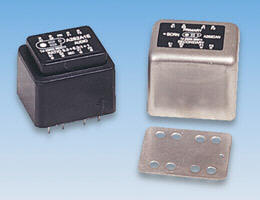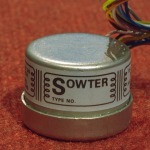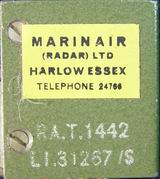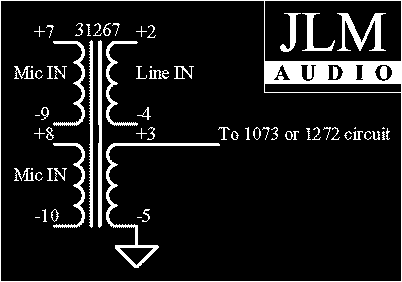 Capturing Audio without Injury
Capturing Audio without InjuryPh +617 38912244 or Skype jlm.audio or MSN / email joe@jlmaudio.com
 Capturing Audio without Injury
Capturing Audio without InjuryPh +617 38912244 or Skype jlm.audio or MSN / email joe@jlmaudio.com |
|||||||
| Home | Products | Kits | Reviews | Schematics | JLM Web Store | JLM Forum | Links |
Neve 10468 Input Transformer Compared to modern Substitutes
DISCLAIMER Only one transformer was tested from each type for the sole purpose of how it performed in a Neve 1272 normal ,1272 modified ,1064,1073,1076,1078 style Mic Pre circuits and for use with the JLM 1272 to 1073 Module. . No batch testing was performed at all. So use of this info is at your own risk. These test were done to help DIY'er get there Neve clones closer to the real thing with out the need for expensive test gear. All transformers tested have been ones suggested to me as possible substitutes in over a hundred or so emails.
|
|
| Test 500Hz Square Test Wave and 20Hz 0.5% & 1% THD level Test Above graph shows one rising edge of the 500Hz Square Wave taken from the transformer secondary winding with a x10 probe into a Tektronix TDS2000 Digital CRO. The test wave used was a 500Hz Square Wave of 400mV Peak to Peak into a real 1073 Neve Module with the substitute transformers wired directly into the 1073. Generator Output Impedances of 50ohm and 200ohm where both tried on each transformer to simulate modern solid state output Mics, Dynamic & Transformer output condenser microphones. The Grey wave form shown was taken while the Neve 10468 was tested after the 50ohm or 200 ohm generator output. The Square wave was pure at the zero ohm output point of the generator. The CRO was adjusted to show all the transformer outputs at the same height. The true voltage out is shown beside each transformers name. The 20Hz THD test shows the level at the input to the transformer at which the core saturates at 20Hz causing the THD to increase dramatically. The test shows the input level at 0.5% and 1% THD.
|
|
 |
What are we looking for ? Ideally a we would like to see one of the substitute transformers wave travel over the top of the Neve 10468 transformer wave so the two looked as one. Even two original 10468 transformers will travel mostly on top of each other but in places the two colours would be still seen. Obviously none of the substitutes tested obtained the holy grail but some are very close and some are just plain wrong. Basic components of the rising edge are the rise time of which we have transformers on both sides of the Neve. Then there is the slight overshoot after which the transformer should settle and not ring. Ringing is the biggest no no when it comes to transformers with to much overshoot being the next in the list of unwanted effects. Overshoot can be treated by zobel or cap loading to bring it with in tolerance. Ringing can be treated like wise but usually will make a larger over shoot and still have smaller but still visible ringing. We also want a transformer with a 20Hz saturation point close to the original Neve 10468 to ensure the transformer core has a similar sound to the Neve 10468 at high levels of bass input . The Neve 10468 has a 0.5% THD @ +7dBM & 1% @ +9dBM at 20Hz.
|
 |
Substitutes from worst to best performance as a Neve 10468 substitute in a 1073 or 1272 Hotrod NOT SUITABLE. The OEP A262A2E which is sold by RS as part no. 210-6419 with screen can 210-6469. And by Farnell part no. 149-155 with screen can 149-157. The transformer was wired as 1:2 with both sets of winding in series. Giving 600:2k4ohms. The idea being that the 6k load on the 2k4ohm side would reflect over 1200 on the 600ohm side just like the 10468 is right and can be done with many transformers but not this one. The ringing was so big I could not fit it on the screen without making all the other graphs to small to easily see. Tried different loading but nothing could control it. This transformer needed a low resistance like 2400ohm across the secondary plus Zobel to fix it which puts it out of the Neve substitute list. So unusable did not do 20Hz test
|
 |
2nd Best or 2nd Worst depending on
how you wire it. The Sowter 9002. I must state that only three
were tested which seemed to be operating in the right ratio. Both windings
were wired in series giving 1:2 (1k2:4k8). This transformer rang badly when
fitted to the Neve 1073. Disconnecting the black screen wire reduced the
ringing by about a third. Changing the 180pF cap across the output of
the transformer to 390pF decreased the ringing but made the overshoot
worse. But ringing was still visible across the top of the whole 500Hz wave.
I could not find this transformer on there web site when I looked. It has
just vanished. It used to be the more expensive version of there Neve 1073
input transformer. The New cheaper replacement the 9145 says it is identical
except a cheaper core is used making the LF response and distortion slightly
worse. Ringing has no place in a pro audio transformer.
BUT
when I swapped the polarity of the secondary so the red was now the 0v
ground all ringing stopped and a good square wave was seen. This was tried
on all three 9002 and found to work perfectly. Attaching the black screen
wire to 0v ground produced only a just visible ringing but nothing like had
been seen with polarity reversed. The three 9002 now had a good square wave
response with one overshoot followed by an under then settled into a flat
line. All three transformers had different overshoot so there is a bit of
tolerance between them. To get the overshoot the same on all three 9002’s
only the 180pF cap across the secondary had to be adjusted. 1 needed 180pF,
1 needed 82pF and one needed on cap to get the same overshoot height as the
10468.
The 9002 now sits speed wise
between the Lundahl LL1538 and the Marinair 10468. This linked with the
similar 20HZ THD point as the Marinair make it a very good substitute for
the 10468. Changing which output
winding is grounded has redistributed how the screen capacitance, and coil
inductance and inter-winding capacitance work together. I have
not added the new Sowter transient plot to the current jpg at the top of the
page yet. |
 |
4th BEST is number 10 the OEP
A262A3E (RS 210-6425 & Can 210-6469) (Farnell 149-156 & Can 149-157). The
OEP was wired in series input & parallel output for a ratio of 1: 3.225
(600:6k25). It is the only useable slower transformer tested and will work
with out any adjustment to the Neve 1073 circuit. While the OEP is
slower (slightly lower bandwidth to 25khz) than the Neve 10468. The OEP A262A3E has a 0.5% THD @ +1.5dBM & a 1% @ 3.5dBM at 20Hz which is less than the Neve 10468 by 5dB but still not to bad.
|
 |
3rd BEST The Lundahl LL1538 &
LL1538XL will also work with no adjustment and its overshoot can be trimmed
by increasing the 180pF cap to 390pF across the secondary of the transformer
if wanted. The Lundahl is faster (higher bandwidth to 100khz) than the Neve
10468. The Lundahl LL1538 has a 0.5% THD @ +8.5dBM & 1%THD @ +11dBM and can handle a dB or two more than the 10468 which is fairly close but slightly more than the 10468. The Lundahl LL1538XL was also tested and has a 0.5% THD @ +12dBM & 1% @ +14.5dBM. So the extra expense of the LL1538XL is not needed for the 1073 clone and the LL1538 is a closer match to the 10468 saturation point.
|
 |
1st Best performer is number 6.
The Neve 31267 line input transformer used backward as a 1:2 both winding in
Parallel for (600:2k4) has one large overshoot which as it is not to
bad but also not to good but can probably be fixed by a zobel. With both
windings in series (2k4:10k) the output has no overshoot and is actually to
rounded or damped for use. But using just one input winding and output
winding and leaving the spares disconnected lines up with the 10468
perfectly. I have seen 31267's used as inputs for clone 1073, 1272 hotrod
Mic pres but never using just one winding but this is a perfect match to the
10468 and also leaves a spare line input winding and second Mic input
winding for out of phase above and below drum Mic techniques.
The Neve 31267 has a 0.5THD @ +7dBM & 1% @ +9dBM at 20Hz which is identical to the 10468 which leads me to believe that the 31267 has two winding each equivalent to the 10468 windings in series which makes perfect sense really. |
 Wiring 31267 as 10468 You can use either Mic IN as the Mic input and leave the other two winding not connected. The Line IN gives you a 1:1 input with 5k input impedance. If you want to use the 2 or 3 inputs at once they need to be resistively feed for them to sum and mix properly. Basically you could have two dynamic mics connected direct to the mic inputs and a synth out with about a 2k resistor in series with its output and they will all mix together. But if you connect a opamp out straight to any input it will kill the level of the other two inputs. WARNING. Using only one primary and secondary coil on the 31267 disables the mechanical hum bucking due to there being two separate bobbins on the U laminates that sit mechanically on opposite sides and directions of the formed O core. |
|